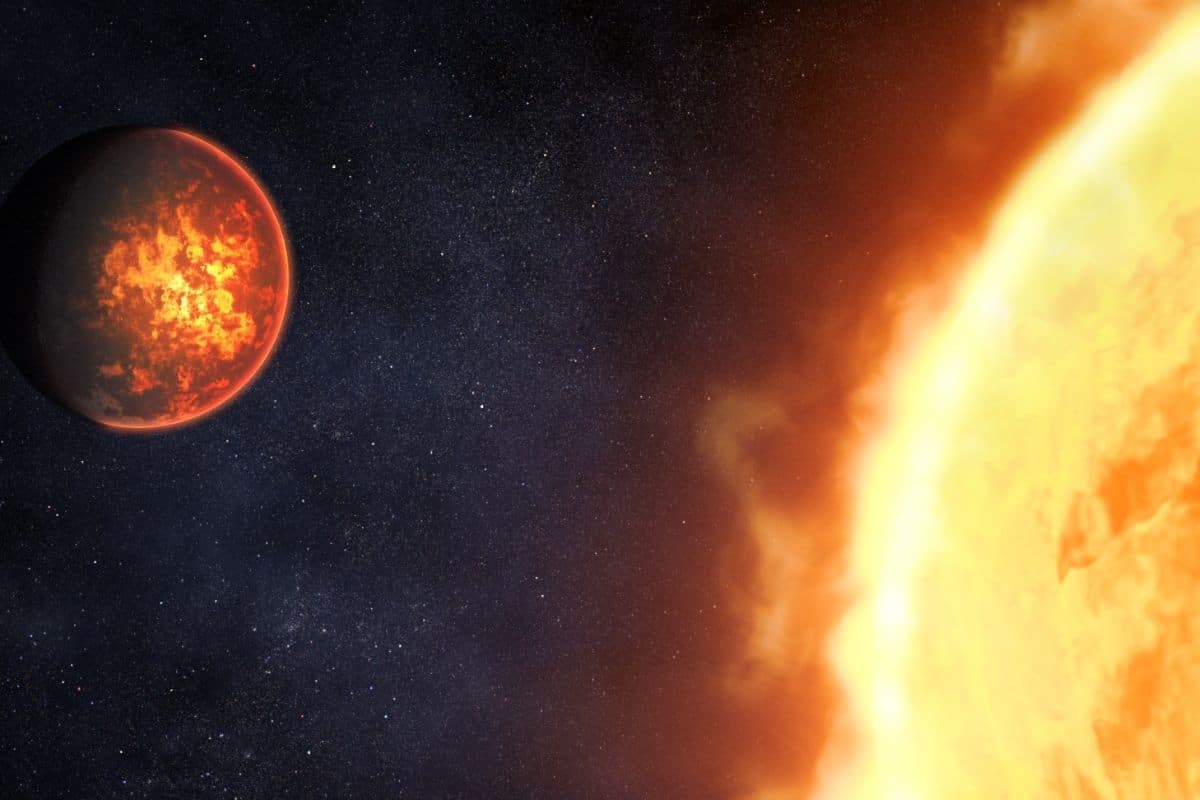

And it’s off to a good start: James Webb kicks off by studying two particularly interesting super-Earths.
Imagine if Earth were much, much closer to the sun. So close that a whole year only lasts a few hours. In one hemisphere it is permanently day, while the other hemisphere is shrouded in endless darkness. Oceans boil away, rocks melt and lava rains from the clouds. While there is no such thing in our own solar system, planets like this – rocky, about Earth-sized, extremely hot and close to their parent star – are not uncommon in the Milky Way galaxy. What do the surfaces and atmospheres of these bizarre planets look like? Space Telescope James Webb is about to provide some answers!
To work
Indeed, because the time has finally come: the James Webb space telescope is about to get started! The telescope was launched on Christmas Day and arrived at its destination about a month later. Over the past few months, engineers have been calibrating the instruments and aligning the mirror segments so that they function together as one large mirror. The powerful space telescope has also cooled down well in the meantime – this is necessary to observe the infrared light from faint, distant objects. So we don’t have to wait much longer. Because in just weeks, James Webb’s exciting mission will finally get underway.
super earths
It’s already off to a good start. Because James Webb will be the first to examine two hot exoplanets, classified as ‘super-Earths’ because of their size and rocky composition. These are the lava-covered 55 Cancri e and the airless LHS 3844 b.

The rocky exoplanets LHS 3844 b and 55 Cancri e compared to Earth and Neptune. Both 55 Cancri e and LHS 3844 b are between Earth and Neptune in size and mass, but are more Earth-like in composition. Image: NASA, ESA, CSA, Dani Player (STScI)
55 Cancri e is about 40 light-years from Earth and orbits precariously around its parent star. For example, this planet has an orbit of less than 18 hours, making it 26 times closer to its parent star than the distance between Mercury and the Sun. It means surface temperatures are rising sharply, potentially covering 55 Cancri e with an ocean of lava.
Mystery
There’s just something crazy about this super-Earth. Planets orbiting so close to their parent star are believed to be ‘tide-locked’. This means that they have a day and night side, with the day side permanently pointed at the parent star. As a result, temperatures are highest at the spot most directly facing the star. In addition, the amount of heat coming from the day side should remain fairly constant over time. But this is both surprisingly not exactly the case at 55 Cancri e.
Atmosphere
It’s up to James Webb to unravel this mystery. “55 Cancri e could have a thick atmosphere dominated by oxygen or nitrogen,” said researcher Renyu Hu. “If 55 Cancri e does have an atmosphere, Webb will be able to detect it and determine what it consists of.” Another possibility is that 55 Cancri e is not tide locked and has a regular day-night cycle. In this scenario, the surface would warm, melt and even evaporate during the day, creating a very thin atmosphere that Webb can detect. In the evening, the vapor would cool and condense, forming droplets of lava that rain on the surface and solidify again when night falls.
LHS 3844 b
While 55 Cancri e will provide insight into the exotic geology of a lava-covered world, LHS 3844 b offers a unique opportunity to analyze the bedrock on an exoplanet. Like 55 Cancri e, LHS 3844 b orbits extremely closely around its parent star, completing one revolution every 11 hours. However, because its parent star is relatively small and cool, temperatures on its surface do not rise extremely high. In addition, previous observations have shown that the planet has no atmosphere. And that’s interesting.
rocks
Although the surface of LHS 3844 b cannot be imaged directly with Webb, the absence of an obscuring atmosphere makes it possible to study the surface by spectroscopy. “Different rock types have different spectra,” explains researcher Laura Kreidberg. “You can see with your own eyes that granite is lighter in color than basalt. And similar differences can be seen in infrared.” The researchers will use MIRI (James Webb’s instrument that focuses on mid-infrared radiation) to study the thermal emission spectrum from the dayside of LHS 3844 b and then compare it with that of known rocks – such as basalt and granite – to determine the composition. If the planet is volcanically active, the spectrum may also reveal traces of volcanic gases.
Interest
The significance of the observations of 55 Cancri e and LHS 3844 b extends far beyond simply studying two of the more than 5,000 confirmed exoplanets. “It gives us fantastic new insight into Earth-like planets,” Kreidberg says. “In addition, it tells us more about what early Earth might have looked like when it was as hot as these planets are now.”
This is just the beginning, by the way. For Webb will explore every phase of cosmic history—from within the solar system to the most distant observable galaxies in the early universe, and everything in between. As a result, this most powerful telescope ever built is expected to reveal new and unexpected discoveries and help humanity better understand the origin of the universe and our place in it.
Source material:
†Geology from 50 Light-Years: Webb Gets Ready to Study Rocky Worlds” – NASA
Image at the top of this article: NASA, ESA, CSA, Dani Player (STScI)